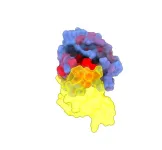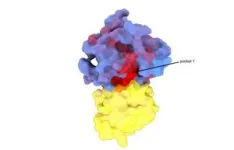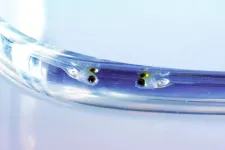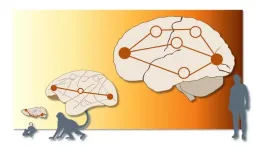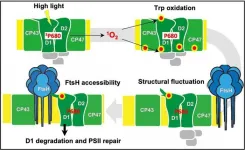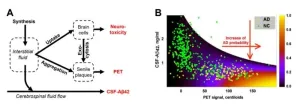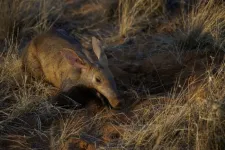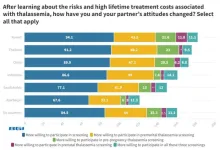(Press-News.org) Researchers at the Centre for Genomic Regulation in Barcelona, Spain, and the Wellcome Sanger Institute near Cambridge, UK, have comprehensively identified the allosteric control sites found in the protein KRAS. These are highly sought after targets for drug development, representing secret vulnerabilities which can be exploited to control the effects of one of the most important causes of cancer. The study presents the first complete control map for any protein and is published today (18 December) in the journal Nature.
KRAS is one of the most frequently mutated genes in cancers of many types. It is found in 1 in 10 human cancers, with higher prevalence in deadly types such as pancreatic or lung cancers. It has been called the ‘Death Star’ protein because of its spherical shape and lack of a good site to target with drugs. For this reason, KRAS has been historically considered ‘undruggable’ since it was first discovered in 1982.
The only effective strategy to control KRAS has been by targeting its allostery communication system. These are molecular signals which work through a remote-control lock and key mechanism. To control a protein, you need a key (a chemical compound or drug) that can open a lock (active site). Proteins can also be influenced by a secondary lock (allosteric site) which lies elsewhere on its surface. When a molecule binds to an allosteric site, it causes a change in the protein's shape, which can alter the protein's activity or its ability to bind to other molecules, for example by changing the internal structure of its main lock.
Allosteric sites are often preferred for drug development as they offer greater specificity, reducing the likelihood of side effects. They can also change a protein's activity more subtly, offering potential for fine-tuning its function. Drugs that target allosteric sites are generally safer and more effective compared to drugs targeting active sites.
However, allosteric sites are highly elusive. Despite four decades of research, tens of thousands of scientific publications, and more than three hundred published structures of KRAS, only two drugs have been approved for clinical use - sotorasib and adagrasib. The drugs work by attaching to a pocket adjacent to the active site, inducing an allosteric conformational change in the protein that prevents it from being activated.
“It took decades to produce a working drug against KRAS partly because we lacked tools to identify allosteric sites at scale, meaning we were looking for therapeutic target sites in the dark. In this study we demonstrate a new approach that can map allosteric sites systematically for entire proteins. For the purposes of drug discovery, it’s like turning the lights on and laying bare the many ways we can control a protein,” explains Dr. André Faure, staff scientist at the Centre for Genomic Regulation and co-author of the study.
Four promising targets for safer, more effective drugs
The authors of the study mapped the allosteric sites by using a technique called deep mutational scanning. It involved creating over 26,000 variations of the KRAS protein, changing only one or two building blocks (amino acids) at a time. The team checked how these different KRAS variations bind to six other proteins, including those critical for KRAS to cause cancer. The researchers used AI software to analyse the data, detect allostery and identify the location of known and new therapeutic target sites.
"The unique selling point of our method is its scalability. In this work alone we made more than 22,000 biophysical measurements, a similar number as the total ever made for all proteins before we started harnessing the remarkable strides in DNA sequencing and synthesis methodologies. This is an enormous acceleration and demonstrates the power and potential of the approach,” explains Chenchun Weng, first author of the study and postdoctoral researcher at the Centre for Genomic Regulation.
The technique revealed that KRAS has many more strong allosteric sites than expected. Mutations in these sites inhibited the protein’s binding to all three of its main partners, suggesting that broadly inhibiting the activity of KRAS is possible. A subset of these sites are particularly interesting as they are located in four different pockets easily accessible on the surface of the protein, and represent promising targets for future drugs.
The authors of the study highlight one in particular – ‘pocket 3’ – as particularly interesting. This pocket is located far away from the active site of KRAS and so has previously received very little attention from pharmaceutical companies.
The researchers also found that small alterations in KRAS can drastically change its behaviour with its partners, making the protein prefer one over another. This has important implications because it could lead to new strategies which control the aberrant activity of KRAS without hampering its normal function in non-cancerous tissues. Sparing normal versions of KRAS means fewer side effects, and safer, more effective treatments. Researchers could also use this knowledge to dig further into the biology of KRAS and explain how the protein behaves in various scenarios, which could be key to determining its role in different cancer types.
New blueprint to drug the ‘undruggable’
The study provides the first ever complete map of allosteric sites for any complete protein in any species. The research shows that with the right tools and techniques, like the ones they used to map KRAS, new vulnerabilities can be uncovered for many different medically-important proteins that have historically been considered ‘undruggable’.
“The big challenge in medicine isn’t knowing which proteins are causing diseases but not knowing how to control them. Our study represents a new strategy to target these proteins and speed up the development of drugs to control their activity. The nature of targeting allosteric sites means that the resulting drugs are likely to be safer, more effective treatments than the ones we have right now,” concludes ICREA Research Professor Dr. Ben Lehner, senior author of the study from the Centre for Genomic Regulation and the Wellcome Sanger Institute.
END
Secret vulnerabilities of cancer’s ‘death star’ revealed
Researchers present first complete control map for KRAS, laying out a fresh blueprint for targeting ‘undruggable’ proteins
2023-12-18
ELSE PRESS RELEASES FROM THIS DATE:
Toronto study identifies new concepts for GLP-1 action in the brain, the 2023 Science magazine breakthrough of the year
2023-12-18
Research pioneer Dr. Daniel Drucker has much to be proud of, as the GLP-1-based diabetes drugs hailing from his early research are named 2023 breakthrough of the year by the Science Magazine.
Not only have millions of people with type 2 diabetes benefitted from GLP-1 agonists, but the drugs also produced wide-ranging health benefits beyond weight loss in two recent patient trials.
For years, GLP-1 agonists have been known to have a fortuitous side effect of improving metabolic health, but how this is regulated in the body remains unclear. Now Dr. ...
Coral atoll islands may outpace sea-level rise with local ecological restoration, scientists say
2023-12-18
Ecological restoration may save coral atoll islands from the rising seas of climate change, according to an international team of scientists, conservationists, and an indigenous leader.
While global carbon emission reduction is imperative, local measures could be the key to the islands outpacing sea levels, they argue today in the journal Trends in Ecology & Evolution.
“Far from being doomed, in their natural state most coral atoll islands could adapt to sea level rise”, says Dr Sebastian Steibl from the University of Auckland ...
NIH researchers create genetic atlas detailing early stages of zebrafish development
2023-12-18
Researchers at the National Institutes of Health have published an atlas of zebrafish development, detailing the gene expression programs that are activated within nearly every cell type during the first five days of development, a period in which embryos mature from a single cell into distinct cell types. These diverse cells become tissues and organs that form juvenile fish capable of swimming and looking for food. The findings are published in Developmental Cell.
“Perhaps surprisingly, tiny zebrafish provide us with significant insight ...
Unleashing canine travel: Hospitality and tourism sector urged to adapt to dog-friendly travel demands
2023-12-18
Estimated to be worth USD 50.1 billion by 2030, a Surrey team of researchers has uncovered the potential of the growing dog-friendly travel market. The Covid-19 pandemic drove an increase in UK household dog ownership, creating a need for tourism providers to adapt to accommodate these four-legged family members.
The Surrey team set out to understand why people travel with their dogs, how they feel about it, and what challenges they face doing so.
Lori Hoy, PhD Researcher and lead author of the study at the University of Surrey, said:
"Some reports suggest that the UK dog population stands at 11 million, with 29% of UK adults having a dog in their ...
More parallel ‘traffic' observed in human brains than in animals
2023-12-18
In a study comparing human brain communication networks with those of macaques and mice, EPFL researchers found that only the human brains transmitted information via multiple parallel pathways, yielding new insights into mammalian evolution.
When describing brain communication networks, EPFL senior postdoctoral researcher Alessandra Griffa likes to use travel metaphors. Brain signals are sent from a source to a target, establishing a polysynaptic pathway that intersects multiple brain regions “like a road with many stops along the way.”
She explains that structural brain ...
The role of oxidized tryptophan residues in repairing damaged photosystem II protein
2023-12-18
Photosynthesis refers to the fundamental biological process of the conversion of light energy into chemical energy by chlorophyll (a green pigment) containing plants. This seemingly routine process in plants sustains all the biological life and activities on Earth. First reaction of photosynthesis occurs at a site called photosystem II (PSII), present on the thylakoid membrane in the chloroplast where light energy is transferred to chlorophyll molecules. PSII is made up of a complex group of proteins, including the D1 and D2 reaction center proteins.
Light ...
Breaking the mold: Zarbio and Georgia State scientists unveil game-changing theory on Alzheimer's disease
2023-12-18
Despite affecting millions worldwide, Alzheimer's disease (AD) has long lacked effective treatments due to a fundamental inadequacy of our understanding of its etiology and pathogenesis. The absence of an integrative theory connecting the molecular origins of AD with disturbances at the organelle and cell levels, changes in relevant biomarkers, and population-level prevalence has hindered progress. Even though most scientists only hope that an integrative theory of AD will emerge soon, scientists from Zarbio and Georgia State University discovered sufficient data to formulate a framework for such a theory.
The molecular and cellular ...
Scientists collect aardvark poop to understand how the species is impacted by climate in Africa
2023-12-18
CORVALLIS, Ore. – In a first-of-its-kind study of aardvarks, Oregon State University researchers spent months in sub-Saharan Africa collecting poop from the animal and concluded that aridification of the landscape is isolating them, which they say could have implications for their long-term survival.
“Everyone had heard of aardvarks and they are considered very ecologically important but there has been little study of them,” said Clint Epps, a wildlife biologist at Oregon State. “We wanted to see if we could collect enough data to begin to understand them.”
In ...
Thalassemia screening in Thailand: Medical Sciences Dean advocates for elevated trust
2023-12-18
- Insights from Professor Sakorn Pornprasert, Dean, Faculty of Associated Medical Sciences at Chiang Mai University, on raising thalassemia awareness in Thailand.
Thalassemia, a genetic disorder affecting hemoglobin production, poses a significant public health challenge in Thailand, with a high prevalence and substantial healthcare costs. According to Thailand's Ministry of Public Health, approximately 18-24 million or 30-40 percent of the Thai population carries the thalassemia gene.
Professor Sakorn Pornprasert, Dean, Faculty of Associated Medical Sciences, Chiang Mai University, shared his views on BGI Genomics Global 2023 State of Thalassemia Awareness ...
Lung nodule program provides benefits patients ineligible for lung cancer screening
2023-12-18
(Denver—December 18, 2023) – Adopting a lung nodule program (LNP) may increase the detection of early lung cancer for patients who are not eligible for lung cancer screening under existing age eligibility criteria, according to a study published in the Journal of Thoracic Oncology, an official journal of the International Association for the Study of Lung Cancer.
LNPs are established to follow up on lung nodules that are frequently identified during routine imaging for reasons other than suspected lung cancer or lung cancer screening.
The research was conducted by a team led by Dr. Raymond U. Osarogiagbon, MBBS, FACP, chief scientist ...
LAST 30 PRESS RELEASES:
Why nail-biting, procrastination and other self-sabotaging behaviors are rooted in survival instincts
Regional variations in mechanical properties of porcine leptomeninges
Artificial empathy in therapy and healthcare: advancements in interpersonal interaction technologies
Why some brains switch gears more efficiently than others
UVA’s Jundong Li wins ICDM’S 2025 Tao Li Award for data mining, machine learning
UVA’s low-power, high-performance computer power player Mircea Stan earns National Academy of Inventors fellowship
Not playing by the rules: USU researcher explores filamentous algae dynamics in rivers
Do our body clocks influence our risk of dementia?
Anthropologists offer new evidence of bipedalism in long-debated fossil discovery
Safer receipt paper from wood
Dosage-sensitive genes suggest no whole-genome duplications in ancestral angiosperm
First ancient human herpesvirus genomes document their deep history with humans
Why Some Bacteria Survive Antibiotics and How to Stop Them - New study reveals that bacteria can survive antibiotic treatment through two fundamentally different “shutdown modes”
UCLA study links scar healing to dangerous placenta condition
CHANGE-seq-BE finds off-target changes in the genome from base editors
The Journal of Nuclear Medicine Ahead-of-Print Tip Sheet: January 2, 2026
Delayed or absent first dose of measles, mumps, and rubella vaccination
Trends in US preterm birth rates by household income and race and ethnicity
Study identifies potential biomarker linked to progression and brain inflammation in multiple sclerosis
Many mothers in Norway do not show up for postnatal check-ups
Researchers want to find out why quick clay is so unstable
Superradiant spins show teamwork at the quantum scale
Cleveland Clinic Research links tumor bacteria to immunotherapy resistance in head and neck cancer
First Editorial of 2026: Resisting AI slop
Joint ground- and space-based observations reveal Saturn-mass rogue planet
Inheritable genetic variant offers protection against blood cancer risk and progression
Pigs settled Pacific islands alongside early human voyagers
A Coral reef’s daily pulse reshapes microbes in surrounding waters
EAST Tokamak experiments exceed plasma density limit, offering new approach to fusion ignition
Groundbreaking discovery reveals Africa’s oldest cremation pyre and complex ritual practices
[Press-News.org] Secret vulnerabilities of cancer’s ‘death star’ revealedResearchers present first complete control map for KRAS, laying out a fresh blueprint for targeting ‘undruggable’ proteins
